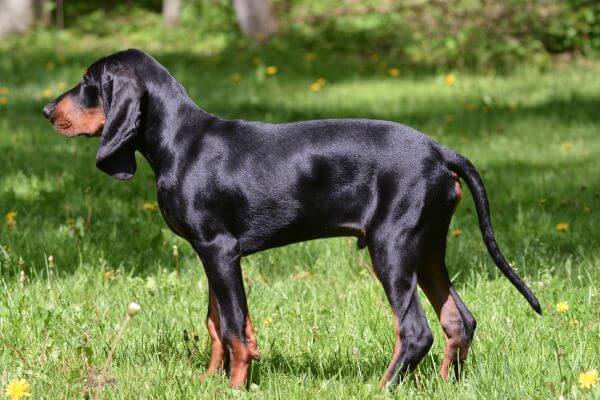The Coonhound is a dog breed that is generally friendly and loyal to family members, with a sociable temperament that is attached to its owners. However, it’s important to remember that temperament can vary from individual to individual, and socialization from a young age is crucial to ensuring he grows up to be a confident, well-adjusted dog. When well socialized, they can get along well with other pets, including dogs and cats.
In this article, we are going to discuss some important issues to consider before getting a Coonhound. We’ll cover the breed’s temperament, as well as how to control excessive barking. We’ll also discuss the breed’s ability to live indoors and how to ensure he has quality of life indoors. Finally, we’ll cover if they shed too much and how to care for their coat. If you are considering getting one this article will provide valuable information to help you decide if this is the right breed for you and your family.

Do Coonhounds bark a lot?
This dog breed is known for its characteristic loud barking, especially when they are in their hunting mode. They were originally bred to hunt raccoons, and their barking was a way of alerting their owners to the location of prey. As a result, they tend to bark more than other breeds, especially if not properly trained.
To control excessive barking, it’s important to start early with obedience training and teach silence commands. Additionally, proper exercise is critical to help keep your dog’s energy levels in check and reduce barking. Giving toys and activities to occupy his time can also help reduce excessive barking.
Some other training techniques that may be helpful include:
- Correcting excessive barking with a firm word, not yelling, and rewarding calm, quiet behavior.
- It’s also important not to inadvertently reinforce the Coonhound’s barking by paying excessive attention or giving in to his demands when he is barking.
With patience and consistency, you can minimize the barking and ensure that your dog is a pleasant and respected companion.
Can Coonhounds Live Indoors?
Despite being a breed created to hunt outdoors, it is also capable of adapting well indoors, as long as its needs are met. However, it is important to remember that this breed needs plenty of exercise and mental stimulation, even indoors. This can include daily walks, interactive games and toys that stimulate your mind.
Ensuring adequate space to move around and play indoors is also critical. This could include an indoor play area or a fenced backyard. In addition, it is important to provide him with a comfortable bed and a quiet resting space where he can relax and feel safe.
Socialization is also important to ensure he is a pleasant, well-adjusted companion in the home. This includes exposure to different people and animals from a young age, as well as obedience training to help control unwanted behaviors such as excessive barking or destroying objects.
Do Coonhounds shed a lot?
Its coat is dense and short, it can vary in color and pattern depending on its lineage. Although it is not a breed that sheds a lot, it is still necessary to take care of its coat to keep it healthy and shiny.
To take care of the coat it is recommended:
- Brush it regularly with a soft bristle brush. This helps remove dead hair and distribute the skin’s natural oils, keeping the coat healthy.
- Bathe regularly, but not excessively, to avoid stripping the skin of its natural oils.
- Check your Coonhound’s ears regularly to ensure they are clean and dry, especially if your Coonhound spends a lot of time outdoors. This helps prevent ear infections.
- Nail trimming is also an important part of coat care, as nails that are too long can cause discomfort and even injury.
With this care, the Coonhound can have a healthy and beautiful coat for many years.
Exercise needs: A routine for your health and happiness
The Coonhound is an energetic and athletic breed of dog, lack of exercise can result in destructive behaviors and anxiety. Therefore, it is important to ensure that your exercise needs are met, such as:
- A daily walk is an important part of exercise, but it’s not enough. They need opportunities to run and play in open spaces, such as a fenced yard or dog park.
- Interactive toys such as balls and fetch games are also great for stimulating your Coonhound’s mind and body.
- Activities like jogging, brisk walking, cycling and dog sports like agility and frisbee are great ways to provide the exercise and mental stimulation they need.
- However, it’s important to remember that over-exercise can also be harmful, especially for young, growing dogs. Always supervise your dog’s physical activities to ensure they are safe and healthy.
What to consider?
Before making the decision to bring a Coonhound home, it is important to consider some factors:
- Family Lifestyle: Assess whether your lifestyle is compatible with the dog’s needs. If you can’t provide them with the exercise and mental stimulation they need, it might be best to look for a breed of dog better suited to their lifestyle.
- Available space: The Coonhound is a medium to large dog that needs room to move and play. If you live in an apartment or small house without a backyard, it can be difficult to provide them with the space they need. Make sure you have enough space to accommodate it before purchasing one.
- Health Care: Like any dog, they need regular health care, including vet visits, vaccinations and parasite prevention. It’s also important to be prepared to deal with any health issues that may arise, such as weight issues, breathing problems, and hereditary illnesses.
- Responsibilities Involved: Caring for a Coonhound is a serious responsibility and involves a number of tasks including feeding, exercising, training and socialization. Also, it’s important to remember that a Coonhound can live up to 12 years or more, which means you’ll be committed to caring for your dog for years to come.
- Training: As it is a dog that can be stubborn and independent, training it can be challenging. It is important to be prepared to invest time and patience in training, using positive reinforcement techniques and consistency.
By considering all of these factors, you can determine if this is the right breed for you and your family. If you decide it’s the right choice, know that they can be wonderful, faithful companions for life.

